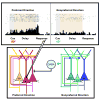Adrenergic pharmacology and cognition: focus on the prefrontal cortex
- PMID: 17303246
- PMCID: PMC2151919
- DOI: 10.1016/j.pharmthera.2006.11.006
Adrenergic pharmacology and cognition: focus on the prefrontal cortex
Abstract
Norepinephrine (NE) has widespread projections throughout the brain, and thus, is ideally positioned to orchestrate neural functions based on arousal state. For example, NE can increase "signal/noise" ratio in the processing of sensory stimuli, and can enhance long-term memory consolidation in the amygdala and hippocampus through actions at alpha-1 and beta adrenoceptors. Over the last 20 years, NE has also been shown to play a powerful role in regulating the working memory and attention functions of the prefrontal cortex (PFC). Moderate levels of NE released under control conditions strengthen prefrontal cortical functions via actions at post-synaptic alpha-2A adrenoceptors with high affinity for NE, while high levels of NE release during stress impair PFC cortical functions via alpha-1 and possibly beta-1 receptors with lower affinity for NE. Thus, levels of NE determine whether prefrontal cortical or posterior cortical systems control our behavior and thought. Understanding these receptor mechanisms has led to new intelligent treatments for neuropsychiatric disorders associated with PFC dysfunction.
Figures



References
-
- Aoki C, Go CG, Venkatesan C, Kurose H. Perikaryal and synaptic localization of alpha-2A-adrenergic receptor-like immunoreactivity. Brain Res. 1994;650:181–204. - PubMed
-
- Aoki C, Venkatesan C, Go CG, Forman R, Kurose H. Cellular and subcellular sites for noradrenergic action in the monkey dorsolateral prefrontal cortex as revealed by the immunocytochemical localization of noradrenergic receptors and axons. Cerebral Cortex. 1998a;8:269–277. - PubMed
-
- Aoki C, Venkatesan C, Kurose H. Noradrenergic modulation of the prefrontal cortex as revealed by electron microscopic immunocytochemistry. Adv Pharmacol. 1998b;42:777–780. - PubMed
-
- Arikuni T, Ban T. Subcortical afferents to the prefrontal cortex in rabbits. Exp Brain Res. 1978;32:69–75. - PubMed
Publication types
MeSH terms
Substances
Grants and funding
LinkOut - more resources
Full Text Sources
Other Literature Sources
Miscellaneous

